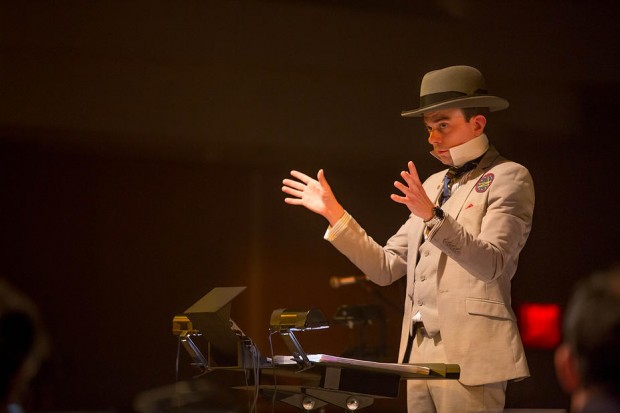False flags, chemtrails, second gunmen and perpetual surveillance. Conspiracy theories are as American as apple pie and have been an integral part of the fabric of this country since before our Founding Fathers even began drafting the Declaration of Independence. At least that’s what Darcy James Argue and Isaac Butler want you to believe.
Widely recognized as one the best living jazz composers, Argue has partnered with Isaac Butler to create Real Enemies—a 12-movement multimedia exploration of the history of conspiracy and paranoia in the American mind.
Composed by Argue, and written and directed by Butler, the piece is slated to make its concert premiere at Bing Concert Hall on the Stanford University campus this Friday. The show will feature a combination of light projections, music from Argue’s 18-piece band, Secret Society, and audio clips of presidential speeches and other sampled recordings. The concert is meant to tell the story of a variety of well-known American conspiracy theories in 12 vignettes—from the first Red Scare, through the assassination of JFK, and on to the present day revelations of CIA contractor Edward Snowden.
When conceiving their piece, Argue and Butler looked to the book Real Enemies: Conspiracy Theories and American Democracy, World War I to 9/11, by Kathryn Olmsted.
Argue, who began reading the book at the recommendation of his girlfriend, says he was at once struck by the “circular nature of conspiracy theories,” and not long after began planning his interpretation of Olmsted’s work.
“I think it’s pretty clear that conspiracy theories occupy a similar place in our culture as myths,” Argue says. “The appeal of conspiracy theories is that they give organization to our world and they give structure and some sort of explanation for why things happen the way they happen that is more comforting to people than just random chance or the idea that some lone wacko did it.”
Butler helped Argue craft his musical composition by creating a detailed outline, or “spine,” inspired by his own reading of Olmsted’s book. As he read through the book, he identified major themes and salient details and organized them into 12 “thematically coherent chapters.”
In addition to the explicatory appeal of conspiracy theories, Butler says his research for this Real Enemies also showed him how valuable they can be for politicians.
“The Declaration of Independence contains a conspiracy theory about the king’s intentions with the colonies,” he says, referring to beliefs about the nefarious designs of King George, which were widely held by colonists in the runup to the Revolutionary War.
More recently, Butler notes, the assertions by President George W. Bush’s administration that Saddam Hussein was seeking yellowcake uranium from Africa and working with al-Qaeda were, in fact, conspiracy theories. Both were used to justify the invasion of Iraq. “Neither were true.”
Argue used a method of composing known as the 12-tone serialism—a style of composing invented Arnold Schoenberg after the mind-boggling, mechanized carnage of World War I prompted him to rethink the process of composition. The musical system, according to Argue, came to define modern music and was perfect for capturing “the sound of mid-century paranoia and angst.”
And so, as Real Enemies moves through each of its 12 vignettes, so will Argue guide his Secret Society through a series of 12 movements, with each movement dwelling on each of the 12 tones in the traditional Western musical scale.
The process ensures that the resulting music will be filled with “dissonant and unsettling sounds, unmoored from traditional modality,” Argue explains—ideal for a history of conspiracy theories.
Adding to the overall 12-toned aesthetic, Butler says he conceived of his outline while thinking about a clock counting down to noon—or perhaps midnight—just like the symbolic Doomsday Clock, which represents humanity’s proximity to global catastrophe.
The use of 12-tone serialism is also ironic, according to Argue—especially considering the circuitous constitution of conspiracy.
In the wake of serialism’s rise in popularity, he notes, a conspiracy theory developed among working musicians that the new system was the brainchild of “a shadowy cabal of academic composers that were controlling the definition of respectable new classical composition.”
Darcy James Argue’s Secret Society will perform ‘Real Enemies’ Oct. 2, at 7:30pm, at Bing Concert Hall at Stanford University.
.Darcy James Argue To Debut Conspiracy Theory-Themed 'Real Enemies,' At Stanford's Bing




